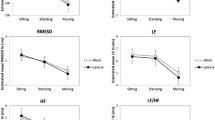Abstract
In the literature, little is known about the vagal response during exposure to a sit-stand workstation. This study measured the vagal response to exposure to a dynamic workstation that moved between sitting and standing heights for different regular durations and documented sex-related response. Fourteen workers (43.6 ± 4.0 years of age; 16.1 ± 4.1 years of experience) who work normally with computers (seven women, seven men of working age) were exposed to a dynamic workstation in their everyday office work environment. Heart rate variability (HRV) was used to measure the vagal activity with SD1, SD2 and MeanRR indicators, and questionnaires measured musculoskeletal health. Indicator of overall physiological response (HRV) to a dynamic workstation appears to be related to sex among a cohort of experienced office workers, where women showed a higher vagal response than men, and men had a decrease in body regions with musculoskeletal discomfort. More attention should provide to sex-specific responses to a dynamic workstation.
Access this chapter
Tax calculation will be finalised at checkout
Purchases are for personal use only
Similar content being viewed by others
References
Koren, K., Pišot, R., Šimunič, B.: Active workstation allows office workers to work efficiently while sitting and exercising moderately. Appl. Ergon. 54, 83–89 (2016). https://doi.org/10.1016/j.apergo.2015.11.013
Järvelin-Pasanen, S., Sinikallio, S., Tarvainen, M.P.: Heart rate variability and occupational stress—systematic review. Ind. Health 56(6), 500–511 (2018). https://doi.org/10.2486/indhealth.2017-0190
Tonello, L., Rodrigues, F.B., Souza, J.W.S., Campbell, C.S.G., Leicht, A.S., Boullosa, D.A: The role of physical activity and heart rate variability for the control of work-related stress. Front. Physiol., 5(67) (2014). https://doi.org/10.3389/fphys.2014.00067
Koenig, J., Loerbroks, A., Jarczok, M.N., Fischer, J.E., Thayer, J.F.: Chronic pain and heart rate variability in a cross-sectional occupational sample: evidence for impaired vagal control. Clin. J. Pain 32(3), 218–25 (2016). https://doi.org/10.1097/AJP.0000000000000242
Wong, I.S., Ostry, A.S., Demers, P., Davies, H.W.: Job strain and shift work influences on biomarkers and subclinical heart disease indicators: a pilot study. J. Occup. Environ. Hyg. 9, 467–477 (2012). https://doi.org/10.1080/15459624.2012.693831
Ramírez, E., Ortega, A.R., Reyes Del Paso, G.A.: Anxiety, attention, and decision making: The moderating role of heart rate variability. Int. J. Psychophysiol. 490, 490–496 (2015). https://doi.org/10.1016/j.ijpsycho.2015.10.007
Kemp, A.H., Quintana, D.S.: The relationship between mental and physical health: insights from the study of heart rate variability. Int. J. Psychophysiol. 89(3), 288–96 (2013). https://doi.org/10.1016/j.ijpsycho.2013.06.018
Hallman, D.M., Ekman, A.H., Lyskov, E.: Changes in physical activity and heart rate variability in chronic neck–shoulder pain: monitoring during work and leisure time. Int. Arch. Occup. Environ. Health 87(7), 735–44 (2014). https://doi.org/10.1007/s00420-013-0917-2
Buckley, J.P., Hedge, A., Yates, T., Copeland, R.J., Loosemore, M., Hamer, M., Bradley, G., Dunstan, D.W.: The sedentary office: an expert statement on the growing case for change towards better health and productivity. Br. J. Sports Med. 49(21), 1357–1362 (2015). https://doi.org/10.1136/bjsports-2015-094618
Shaffer, F., Ginsberg, J.P.: An overview of heart rate variability metrics and norms. Front. Public Health. 5, 258 (2017). https://doi.org/10.3389/fpubh.2017.00258
Kuorinka, I., Jonsson, B., Kilbom, A., Vinterberg, H., Biering-Sørensen, F., Andersson, G., et al.: Standardised Nordic questionnaires for the analysis of musculoskeletal symptoms. Appl. Ergon. 18(3), 233–237 (1987). https://doi.org/10.1016/0003-6870(87)90010-x
Lindberg, C.M., et al.: Effects of office workstation type on physical activity and stress. Occup. Environ. Med. 75(10), 689–695 (2018). https://doi.org/10.1136/oemed-2018-105077
Chambers, A.J., Robertson, M.M., Baker, N.: The effect of sit-stand desks on office worker behavioral and health outcomes: a scoping review. Appl. Ergon. 7, 37–53 (2019). https://doi.org/10.1016/j.apergo.2019.01.015
Mengistab, D.: Sedentariness, productivity, perception and long term health effects of sit-stand workstation at work: a literature review. Thesis. New Jersey Institute of Technology. (2019). https://digitalcommons.njit.edu/theses/1657
Black, N.L., Tremblay, M., Mougnol, G., McGrath, M., Kengne, P.: Challenges of controlled measures in real Office environments: Impact of workstation stand-sit height variations. In: Proceedings of the 49th Annual Conference of the Association of Canadian Ergonomists and 6th Conference of CROSH, pp. 47–48 (2018). https://crosh.ca/wp-content/uploads/2018/10/FINAL-Conference-Proceedings-ACE-CROSH-2018_sm.pdf
Author information
Authors and Affiliations
Corresponding author
Editor information
Editors and Affiliations
Rights and permissions
Copyright information
© 2021 The Author(s), under exclusive license to Springer Nature Switzerland AG
About this paper
Cite this paper
Tremblay, M., Black, N.L., Morin, JP. (2021). Dynamic Workstation Exposure: Does Sex Affect Response?. In: Black, N.L., Neumann, W.P., Noy, I. (eds) Proceedings of the 21st Congress of the International Ergonomics Association (IEA 2021). IEA 2021. Lecture Notes in Networks and Systems, vol 220. Springer, Cham. https://doi.org/10.1007/978-3-030-74605-6_63
Download citation
DOI: https://doi.org/10.1007/978-3-030-74605-6_63
Published:
Publisher Name: Springer, Cham
Print ISBN: 978-3-030-74604-9
Online ISBN: 978-3-030-74605-6
eBook Packages: EngineeringEngineering (R0)




